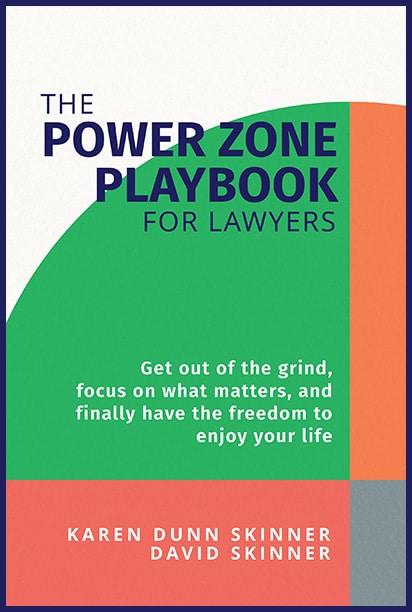The problem isn’t that you don’t know how to plan. The problem is that most law firm annual planning processes focus on creating the plan — not following it. Here’s Karen and David Skinner’s reality-proofed, six-step approach to planning your year.

Table of contents
- Reality-Proofed Approach to Creating and Following Your Law Firm’s Annual Plan
- 1. Start with a short, honest debrief of the year
- 2. Use AI to accelerate your strategic thinking
- 3. Set annual goals using the ABC formula
- 4. Break goals down and assign one clear owner
- 5. Build a weekly rhythm
- 6. Keep Goals Visible
- A Strong Annual Plan Is a Good Start
- More Process Improvement Tips for Your Law Practice
Last November, we shared five steps to make annual planning simpler and more effective. You may remember them: review the past year, assess your strengths and weaknesses, set meaningful goals, break those goals down, and revisit them regularly throughout the year.
The question is, did you do it?
If your answer is “Kind of …” or “Not really …,” you’re in very good company. Everyone starts the year with the best of intentions, and then real life happens. Clients call. A trial gets scheduled. Staff leave. The inbox fills. The year speeds up — and your beautifully crafted plan quietly slides to the back of the drawer.
The problem is that most annual planning processes focus on creating the plan, rather than doing it. After all, creating is the fun part. It’s executing that’s hard work.
Reality-Proofed Approach to Creating and Following Your Law Firm’s Annual Plan
So, with that in mind, here’s an updated, streamlined and (hopefully) reality-proofed approach to law firm annual planning. This approach acknowledges how law firms actually run and is designed to ensure you make a plan and follow it, focusing on sound law firm strategic planning.
1. Start with a short, honest debrief of the year
Look back at your long-term vision and the goals you set last year.
- What moved forward?
- What stalled?
- What surprised you?
- What did you intend to do … but didn’t?
As you look at what worked and what didn’t, don’t treat unfinished goals as failures. Treat them as feedback. Your performance over the past year is just data. Use it, don’t judge it.
And don’t be afraid to adjust your vision, not because you’re backing down, but because you’re evolving.
2. Use AI to accelerate your strategic thinking
Yes, you should look at your strengths, weaknesses, opportunities and threats. But you don’t have to build that analysis from scratch. Use AI to draft a first pass, so you can spend more time making high-value strategic decisions.
Try a prompt like:
“You are a seasoned business strategist and coach who specializes in helping law firm owners uncover hidden opportunities, optimize services, and set up sustainable growth strategies. You know our business from all of our previous chats, and from the numbers I have uploaded to this chat. I want to finish 2025 strong, but I also want to use Q4 as a runway to set myself up for a clear, focused, and profitable 2026.
Your task: Identify 3–5 hidden profit opportunities or overlooked revenue sources I can leverage in Q4 2025. Identify 3–5 strategic moves I should focus on to prepare for 2026 (what to prune, revise, optimize, rework, or create). Keep advice practical and tailored to a law firm at the [insert your revenue stage]—not just starting out. Balance short-term action with long-term clarity and momentum.
Output format:
Section 1: Hidden Profit Opportunities in Q4 2025 (bullet points)
Section 2: Strategic Moves to Set Up 2026 (bullet points)”
AI doesn’t replace your judgment. It accelerates it.
I used this exact prompt last week and asked George (our ChatGPT) to identify hidden revenue opportunities and potential revenue boosters. It gave an excellent analysis of our numbers and a suggestion we’re already acting on.
3. Set annual goals using the ABC formula
We coach all our clients to set their goals using this simple formula:
We will accomplish A by B because of C.
A = the result
B = the deadline
C = the reason (your motivation)
For example:
- We will increase revenue to $1.3M by December 31, 2026, so we can continue to support our team and scale the firm responsibly.
- I will shift 50% of my work to mediation by December 31, 2026, because I believe my clients need a less confrontational way to resolve their disputes, and I need less stress.
The ABC approach to law firm annual planning gives you an explicit target, a deadline and, most importantly, a reason. Don’t skip that part.
Your “why” fuels your follow-through.
4. Break goals down and assign one clear owner
If your goals are huge, it’s easy to get overwhelmed and procrastinate. Start by breaking big goals down into smaller milestones. We like to set these quarterly, or even more frequently if it makes sense.
The next step is to assign some responsibility.
For each goal, assign:
- One accountable owner
- Quarterly milestones
- Monthly or weekly checkpoints
Remember: If everyone owns a goal, no one owns the goal.
5. Build a weekly rhythm
The key to law firm execution is cadence. If you only check in on your goals every three months, you’re getting lagging information. A full quarter may have gone by with little progress, and that’s three months you’re never getting back. Instead, make reviewing your progress a weekly thing.
Consider this weekly cadence:
Monday: 15-minute priority check. Are key tasks on your agenda for the week?
Wednesday: 10-minute progress review. Are you on track to finish the task by Friday?
Friday: 10-minute close and adjust. If you didn’t finish, don’t beat yourself up. Just make sure you block time on the schedule for next week.
Small weekly adjustments prevent big quarterly surprises.
6. Keep Goals Visible
You’ll increase your chances of success if you make your goals simple, visible and achievable. Visibility is key. Not in a drawer. Not in a PDF in a random folder on your laptop. Not buried in your Notes app.
They need to be on the wall, on your task board or in your workflow tool. If you’re already using a project management platform like Trello, Asana or Monday.com, or you’re using Planner or Clio Tasks, you’ve got a tool you can use. Get your goals, milestones and checkpoints into your tools and onto everyone’s calendars as well.
If your goals aren’t visible, they won’t stay relevant.

A Strong Annual Plan Is a Good Start
The lawyers who actually change their practices are the ones who build systems, protect their time and surround themselves with the right support. If you already know what you want your practice to look like—and you’re ready for the structure and accountability to make it happen—we can help. Our coaching programs are designed for lawyers who are tired of running their practices on willpower alone and are ready to lead with intention.
Schedule a strategy session and let’s set your firm up to run smoothly, profitably, and on your terms!
More Process Improvement Tips for Your Law Practice
- The 3 Best Reasons to Use Visual Matter Management to Run Your Law Practice
- 5 Tips to Make Time Entry Less Painful for Lawyers
- Law Firm Intake: 3 Tips to Save Time and Convert More Clients
- New Client Onboarding: 5 Tips to Win Over New Clients
- Time to Build Your Team: 5 Steps to Improve Your Hiring Process
- From Hire to Higher: 6 Ways to Improve Employee Onboarding

Get the Power Zone Playbook for Lawyers
By Karen Dunn Skinner and David Skinner
Get out of the grind and into your power zone! Learn to align the work you do with the work you love, finding the sweet spot where your expertise, passion, and client needs intersect. It’s here, in your Power Zone, that you will discover the secret to a thriving practice.
Everything you need is in your Playbook.
Images © iStockPhoto.com















